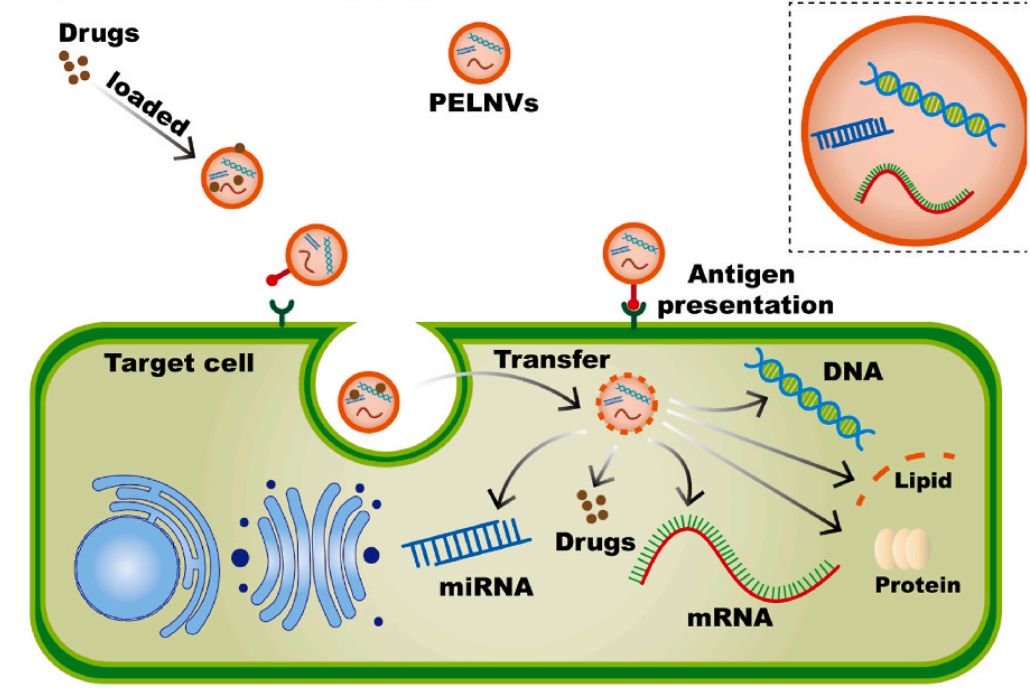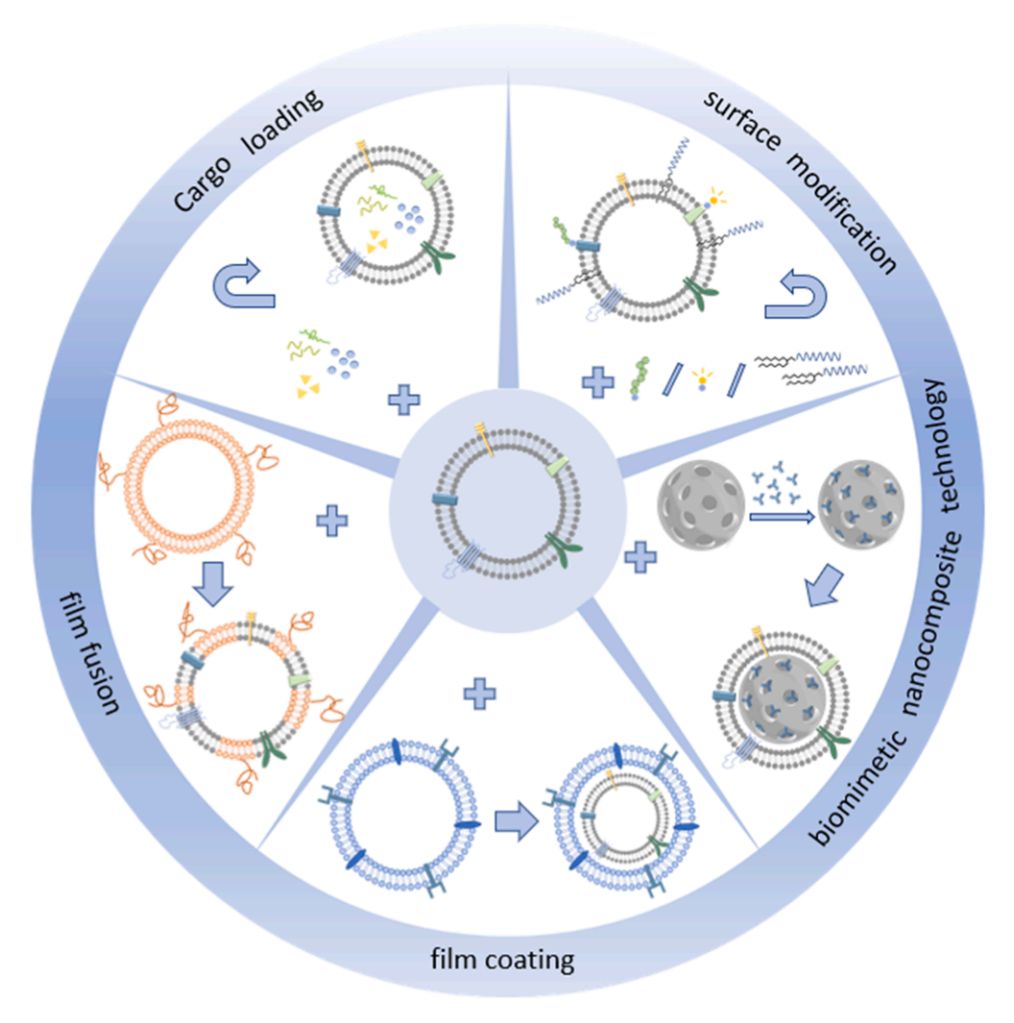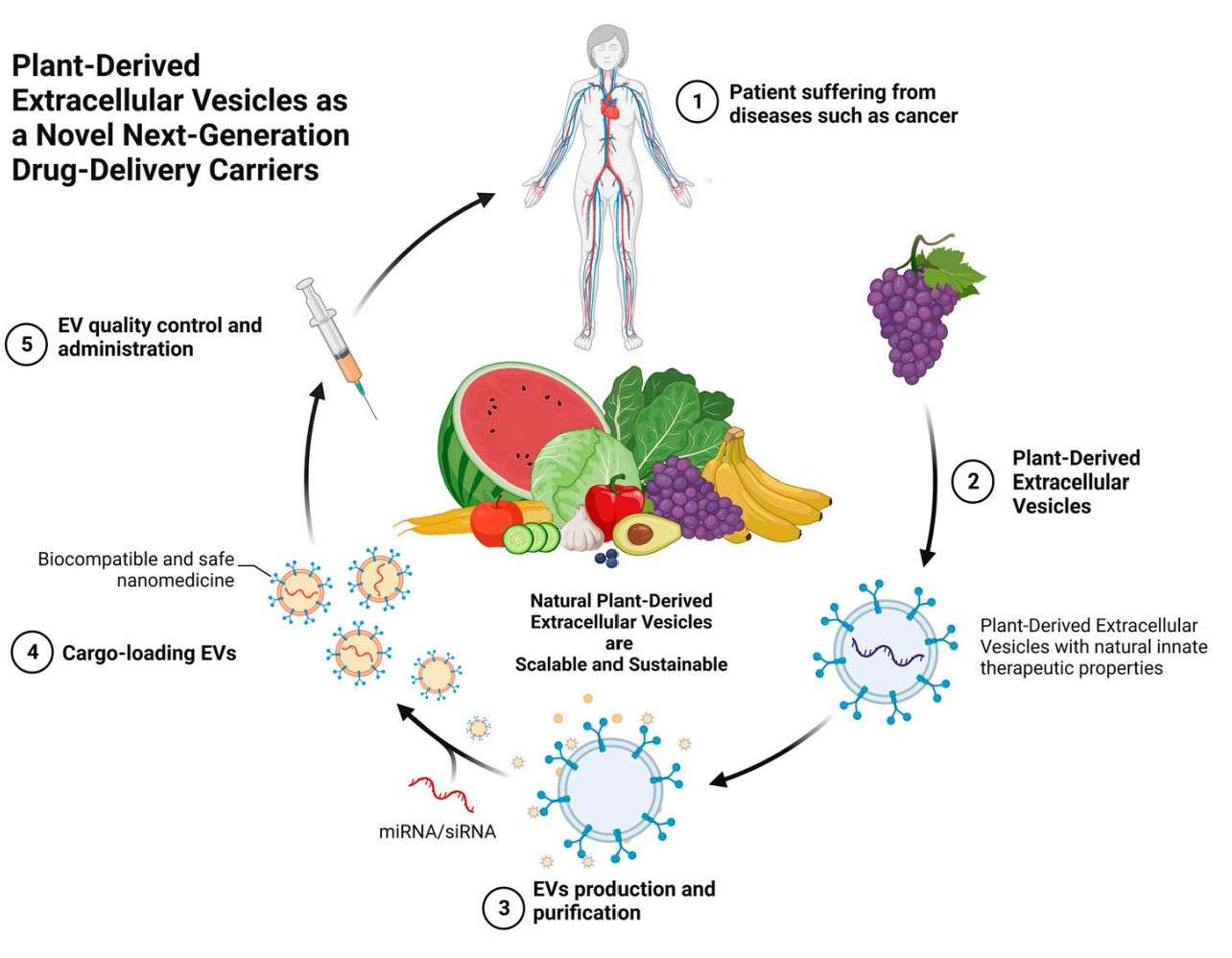Plant-derived Exosomes as Green Delivery Platforms
Plant-derived exosomes are enriched with nucleic acids, proteins, lipids, and secondary metabolites similar to donor cells, and play an important role in intercellular communication, information transfer, and maintenance of homeostasis in the body. In recent years, plant-derived exosomes have shown great potential for medical applications as sustainable and efficient drug delivery nanocarriers.
 Figure 1. Plant-derived exosomes load drugs and target receptor cells. (Jin Z, et al., 2024)
Figure 1. Plant-derived exosomes load drugs and target receptor cells. (Jin Z, et al., 2024)
Drug Delivery Advantages of Plant-derived Exosomes
Plant-derived exosomes have the following advantages as a next-generation drug delivery system:
- High biocompatibility, low immunogenicity, and few toxic side effects.
- Can circulate to all parts of the body and can even deliver drugs across the blood-brain and placental barriers.
- The lipid bilayer protects the internal molecules and stabilizes them in peripheral circulation, ultimately reaching the target cells.
In recent years, scientists have used engineered plant-derived exosomes to achieve targeted therapies at pathological sites.
- In gene therapy, by loading therapeutic genes into plant-derived exosomes, it is possible to achieve targeted and efficient treatment of genetic diseases, improving the precision of treatment and reducing potential risks.
- In tumor immunotherapy, plant-derived exosomes loaded with antigens or immunostimulatory drugs can activate the body's immune system and inhibit tumor growth and metastasis.
- In regenerative medicine, plant-derived exosomes loaded with growth factors or transcription factors can promote tissue repair and regeneration.
How to Isolate Plant-derived Exosomes?
Animal-derived exosomes are isolated from biological fluids, while plant-derived exosomes are isolated from exosomal wash solutions. Leaves are the best choice for collecting exosomal wash solutions to minimize cell damage and contamination. Extraction of exosomal wash solution from plant leaves is performed by tissue infiltration and low-speed centrifugation. As with animal-derived exosome isolation, differential ultracentrifugation is the most widely used method for isolating plant-derived exosomes and has been used to isolate exosomes from different plant species. In this method, dead cells, cellular debris, and large vesicles are first removed by centrifugation at low speeds (2,000×g and 10,000×g). The supernatant is then centrifuged at high speed (100,000×g) to precipitate the exosomes. In addition, the exosomes can be further purified by density gradient centrifugation, which uses sucrose and iodixanol as media to obtain higher-quality exosomes.
 Figure 2. Schematic of plant extracellular vesicle (EV) isolation. (Chen Y-X, Cai Q., 2023)
Figure 2. Schematic of plant extracellular vesicle (EV) isolation. (Chen Y-X, Cai Q., 2023)
Modification of Plant-derived Exosomes
Plant-derived exosomes are attractive emerging therapies as delivery vehicles capable of mediating intercellular communication by transporting functional cargoes to recipient cells. However, their application is still hindered by low targeting and poor homologous effects. Therefore, scientists have developed advanced technologies such as surface modification, cargo loading, biomimetic composite nanotechnology, and artificial modification to engineer plant-derived exosomes, expanding their applications, and facilitating their binding to specific target cells, thereby improving therapeutic efficiency. For example, through chemical coupling, researchers have integrated compounds such as peptides and proteins with exosome membranes to improve exosome targeting while maintaining integrity, thereby improving therapeutic efficacy.
 Figure 3. Overview of methods for the modification of plant-derived exosomes. (Mingyue Shao, et al., 2023)
Figure 3. Overview of methods for the modification of plant-derived exosomes. (Mingyue Shao, et al., 2023)
How to Load Drugs into Plant-derived Exosomes?
- Passive Loading Method
The passive method is simple to operate and is realized by different gradients of drug concentration. The method is based on the incubation of the drug with exosomes or cells and further isolation of exosomes containing the drug. However, this method has low loading efficiency and low output drug concentration and is suitable for hydrophobic drugs.
- Active Loading Method
Active loading methods allow for higher loading efficiency and include sonication, electroporation, extrusion, and freeze-thaw. These methods do not alter the properties of the exosome membrane but increase in exosome volume. It is also possible to bind drugs to exosomes via antibodies or click chemistry. The introduction of a specific receptor into the membrane allows the exosome to be targeted to the desired cell.
Plant-derived Exosomes as Drug Carriers for Disease Treatment
Plant-derived exosomes are natural, nanoparticles with lipid bilayers that can be used as drug delivery platforms. Currently, drugs delivered using plant-derived exosomes are mainly nucleic acid drugs and small molecule chemical drugs.
 Figure 4. Plant-derived exosomes as novel drug delivery carriers. (Alzahrani FA, et al., 2023)
Figure 4. Plant-derived exosomes as novel drug delivery carriers. (Alzahrani FA, et al., 2023)
- Plant-derived Exosomes Deliver Nucleic Acids
Plant-derived exosomes are capable of delivering nucleic acids such as siRNAs and miRNAs. For example, exosomes from grapefruit can deliver RNA and DNA to recipient cells by modifying the target ligand, folate, to enable targeted delivery of drugs to CT-26 and SW620 cells, thereby inhibiting tumor growth. The cherry-derived exosomes deliver small RNA to the digestive system, making them a potential option for oral delivery of nucleic acids. In addition, ginger-derived exosomes loaded with siRNA-CD98 can be orally administered to effectively target colon tissue and reduce CD98 expression. Common methods for introducing exogenous nucleic acids into plant-derived exosomes include electroporation, sonication, incubation, extrusion, and chemical transfection.
- Plant-derived Exosomes Deliver Small Molecules and Drugs
Plant-derived exosomes can be delivered through the nasal cavity to reach the brain, making them an efficient drug delivery option. Grapefruit-derived exosomes can deliver chemotherapeutic and protein drugs to a variety of cells. Ginger-derived exosomes can improve targeting by binding to folic acid. When loaded with the chemotherapeutic drug Adriamycin, it exhibited improved tumor suppression efficacy and good biocompatibility. Ginger-derived exosomes also exhibited better pH-dependent drug release properties compared to commercial liposomal adriamycin.
Products We Offer
Plant-derived exosomes have been widely used in drug carrier research due to their low biotoxicity, high drug-carrying efficiency, low preparation cost, and large-scale isolation. In clinical disease treatment, loading drugs into exosomes can significantly enhance their biological effects and improve the efficacy of disease treatment. Edible plant-derived exosomes have become a hot research topic in recent years, providing a new research direction for safe nano-drug delivery carriers.
Creative Biostructure specializes in the study of plant-derived exosomes. We provide high-quality, globally deliverable exosome products to help clients explore the potential applications of plant-derived exosomes in drug delivery.
| Cat No. | Product Name | Source |
| PNE-FLP04 | PNExo™ Exosome-Lily | Exosome derived from Lily |
| PNE-FLL05 | PNExo™ Exosome-Jasmine | Exosome derived from Jasmine |
| PNE-FLD10 | PNExo™ Exosome-Daffodil | Exosome derived from Daffodil |
| PNE-FLM21 | PNExo™ Exosome-Morning glory | Exosome derived from Morning glory |
| PNE-FLB23 | PNExo™ Exosome-Balsam | Exosome derived from Balsam |
| PNE-FLC24 | PNExo™ Exosome-Canna | Exosome derived from Canna |
| PNE-FLC68 | PNExo™ Exosome-Cockscomb | Exosome derived from Cockscomb |
| PNE-FLG70 | PNExo™ Exosome-Green Tea | Exosome derived from Green Tea |
| PNE-FA18 | PNExo™ Exosome-Apple | Exosome derived from Apple |
| PNE-FB33 | PNExo™ Exosome-Blackberry | Exosome derived from Blackberry |
| PNE-FB34 | PNExo™ Exosome-Blueberry | Exosome derived from Blueberry |
| PNE-FC48 | PNExo™ Exosome-Cherry | Exosome derived from Cherry |
| PNE-FD50 | PNExo™ Exosome-Durian | Exosome derived from Durian |
| PNE-FC54 | PNExo™ Exosome-Coconut | Exosome derived from Coconut |
| PNE-FP93 | PNExo™ Exosome-Prickly Pear | Exosome derived from Prickly Pear |
| Exo-PDELN01 | HQExo™ Exosome-Garlic | Exosome derived from Garlic |
| PNE-VC02 | PNExo™ Exosome-Celery | Exosome derived from Celery |
| Exo-PDELN02 | HQExo™ Exosome-Ginger | Exosome derived from Ginger |
| PNE-VC04 | PNExo™ Exosome-Cucumber | Exosome derived from Cucumber |
| Exo-PDELN04 | HQExo™ Exosome-Potato | Exosome derived from Potato |
| PNE-VB13 | PNExo™ Exosome-Broccoli | Exosome derived from Broccoli |
| PNE-VC15 | PNExo™ Exosome-Cabbage | Exosome derived from Cabbage |
| Explore All Exosomes Isolated from Plants | ||
If you are interested in our exosome services and products, please feel free to contact us.
References
- Jin Z, et al. Plant-derived exosome-like nanovesicles: A novel nanotool for disease therapy. Heliyon. 2024. 10(9): e30630.
- Chen Y-X, Cai Q. Plant Exosome-like Nanovesicles and Their Role in the Innovative Delivery of RNA Therapeutics. Biomedicines. 2023. 11(7): 1806.
- Mingyue Shao, et al. Plant-derived extracellular vesicles - a novel clinical anti-inflammatory drug carrier worthy of investigation. Biomedicine & Pharmacotherapy. 2023. 169: 115904.
- Alzahrani FA, et al. Plant-Derived Extracellular Vesicles and Their Exciting Potential as the Future of Next-Generation Drug Delivery. Biomolecules. 2023. 13(5): 839.
